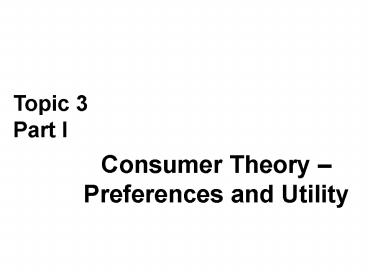Consumer Theory Preferences and Utility - PowerPoint PPT Presentation
1 / 12
Title:
Consumer Theory Preferences and Utility
Description:
Suppose u(x) is a utility function that represents a preference relation. Then v(x) also represents that preference relation iff v(x) = f(u(x)) for every x, where ... – PowerPoint PPT presentation
Number of Views:266
Avg rating:3.0/5.0
Title: Consumer Theory Preferences and Utility
1
Topic 3 Part I
Consumer Theory Preferences and Utility
2
Axioms of Consumer Choice
- The axioms of consumer choice formalize the view
that the consumer can choose and that choices are
consistent in a particular way - We require that consumers can make binary
comparisons, i.e., examine two consumption plans
which pertain to the consumption set X (set of
all alternatives, whether some of them will be
achievable or not) and make a choice
3
Axioms of Consumer Choice
- Rank of preferences
- Axiom 1 Completeness
- For all x1 and x2 in X, either x1 is at least
as good as x2, x2 is at least as good as x1,
or x1 is indifferent to good x2 - i.e., the consumer can always make comparisons
4
Axioms of Consumer Choice
- Axiom 2 Reflexivity
- For all x1 in X, x1 is at least as good as x1
5
Axioms of Consumer Choice
- Axiom 3 Transitivity
- For any three elements, x1, x2 and x3 in X, if
x1 is at least as good as x2 and x2 is at least
as good as x3, then x1 is at least as good as x3
- i.e., the consumer should make consistent
choices - These three axioms imply that the consumer can
completely rank the consumption bundles, i.e.,
the consumers preferences can be represented by
a preference relation
6
Axioms of Consumer Choice
- Technical assumption
- Axiom 4 Continuity
- Roughly speaking, if an individual reports that
x1 is preferred to x2, then situations suitable
close to x1 must also be preferred to x2
7
Axioms of Consumer Choice
- Assumptions on tastes
- Axiom 5 Strong Monotonicity
- If x1 ? x2 and x1 ? x2, then x1 is preferred to
x2 - At least as much of every good, and strictly more
of - some good, is strictly better
8
Axioms of Consumer Choice
- Axiom 6 Strict Convexity
- Given x1 ? x2 and x3 in X, if x1 is at least as
good as x3 - and x2 is at least as good as x3, then tx1 (1
t) x2 is - preferred to x3, for all 0 lt t lt 1
- Strict convexity implies that an agent prefers
averages - to extremes
9
Existence of a Utility Function
- Suppose that preferences are complete, reflexive,
transitive, continuous and strongly monotonic.
Then, there exists a continuous utility function
u Rn ? R which represents those preferences
10
Nonuniqueness of Utility Measures
- Invariance of the utility function to positive
monotonic transformations - Suppose u(x) is a utility function that
represents a preference relation. Then v(x) also
represents that preference relation iff v(x)
f(u(x)) for every x, where - f R ?R is strictly increasing on the set of
values taken on by u - Utility functions provide only ordinal
information - Note f is strictly increasing if f(x0) gt f(x1)
whenever x0 gtgt x1
11
Indifference Surfaces
- They show the combinations of consumption plans
that provide the same level of utility (i.e.,
individual is indifferent) - In the two-good case, X R2, they are called
indifference curve
12
Indifference Surfaces
- The absolute value of the slope of the
indifference curve is the marginal rate of
substitution (willingness to trade bundles such
that keep same level of utility), MRS - Under the preference axioms 1-6, the indifference
curves are strictly convex (no flat portions) - Strict convexity reflects the diminishing MRS































